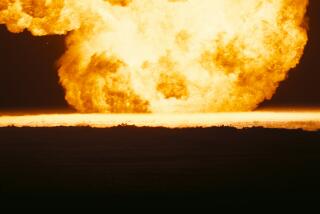John Huizenga dies at 92; physicist helped discredit ‘cold fusion’
On Nov. 1, 1952, U.S. scientists detonated the first hydrogen bomb over Eniwetok Atoll in the Pacific, introducing a powerful new weapon of war and, in the process, atomizing the rocky island. Air Force planes flying through the debris clouds collected small amounts of airborne particles on filter paper and rushed them back to laboratories in Berkeley and Illinois for analysis.
In Illinois, a team that included physicist John R. Huizenga analyzed the minute quantities of material on the filters and discovered elements 99 and 100 on the periodic table, named einsteinium and fermium, respectively, after physicists Albert Einstein and Enrico Fermi, who had recently died. Similar results were obtained at Berkeley.
Huizenga went on to have a long, fruitful career in physics, including a key role in discrediting the “scientific fiasco” that was known as cold fusion. A longtime University of Rochester professor, he died Jan. 25 in La Jolla of congestive heart failure, his family said. He was 92.
“Throughout his 50-year career, John Huizenga conducted research at the forefront of nuclear physics and contributed a host of exceptional insights to nuclear science and technology which stimulated vigorous research then and are still valid today,” University of Rochester physicist Wolf-Udo Schröder said in a statement.
John Robert Huizenga was born April 21, 1921, in Fulton, Ill., where his parents ran a large farm. He was educated in a one-room schoolhouse until he attended high school. His teachers recognized early on that he was a math prodigy and he was “by acclaim, sucked into science,” said his son, Dr. Robert Huizenga of Los Angeles.
He studied physics at Calvin College, a small Christian school in Grand Rapids, Mich., where he was also a star on the basketball team and played semi-pro baseball. His son said he was more comfortable with science than with people, and that his mother, Dolly, had to initiate the romance that led to their marriage.
After receiving his bachelor’s degree in early 1944, Huizenga was recruited along with many other physics students for the Manhattan Project, the highly secret effort to build an atomic bomb. He was sent to work in Oak Ridge, Tenn., in a facility where small quantities of bomb-grade uranium were isolated from crude uranium ore. He quickly rose through the ranks and was put in charge of the laboratory that ensured the purity of the product.
After the war, he attended the University of Illinois, where he received his doctorate in 1949, then joined the Argonne lab outside Chicago. In 1967, he moved to the University of Rochester in NewYork to become a professor of chemistry and physics and remained there for the rest of his career.
As the Cold War ended, diplomatic officials tried to ease tensions by promoting scientific exchanges with Russia and, later, China. Physicists were especially in demand, and Huizenga was one of the first sent to lecture and consult in the Soviet Union. A visit to China in 1979 led Chinese leader Deng Xiaoping to send his youngest son, Deng Zhifang, to study with Huizenga in Rochester.
In 1989, chemists Stanley Pons and Martin Fleischmann at the University of Utah stunned the scientific world with their claims that they had induced fusion reactions at room temperatures, a feat that would bypass the massive, expensive fusion reactors then being built and open the door to a cheap and virtually inexhaustible source of energy. They claimed that under an electrical current, atoms of deuterium in heavy water would fuse into tritium in platinum electrodes, releasing usable heat and neutrons.
Many scientists were skeptical, however, and attempts to reproduce their results appeared futile. Because of the potential implications of the finding, the U.S. Department of Energy established the Energy Research Advisory Board, co-chaired by Huizenga and Norman Ramsey, to investigate.
The 22-member panel concluded that the finding was simply too good to be true. Researchers were never able to identify free neutrons produced by the hypothetical fusion reaction and careful measurements failed to find any excess heat.
Although the report acknowledged that not all of the claims could be ruled out, it essentially sounded the death knell for cold fusion. The panel concluded that the original research entailed a combination of sloppy techniques and wishful thinking. A few scientists continue to study the phenomenon but have produced no credible evidence to suggest that it is real.
Cold fusion, Huizenga told the New York Times in 1999, “is as dead as ever. It’s quite unbelievable that the thing has gone on for 10 years.”
Huizenga, who won numerous awards for his research on radioactive elements, detailed his experiences in a 1992 book, “Cold Fusion: The Scientific Fiasco of the Century.” In 2009 he summarized his career in a memoir, “Five Decades of Research in Nuclear Science.”
He retired to North Carolina to pursue his second passion, golf, but abandoned the game and moved to La Jolla as his heart condition worsened.
Dolly, his wife of 54 years, died in 1999. Huizenga is survived by two daughters, two sons, two sisters and three grandchildren.
Maugh is a former staff writer.
More to Read
Start your day right
Sign up for Essential California for the L.A. Times biggest news, features and recommendations in your inbox six days a week.
You may occasionally receive promotional content from the Los Angeles Times.






